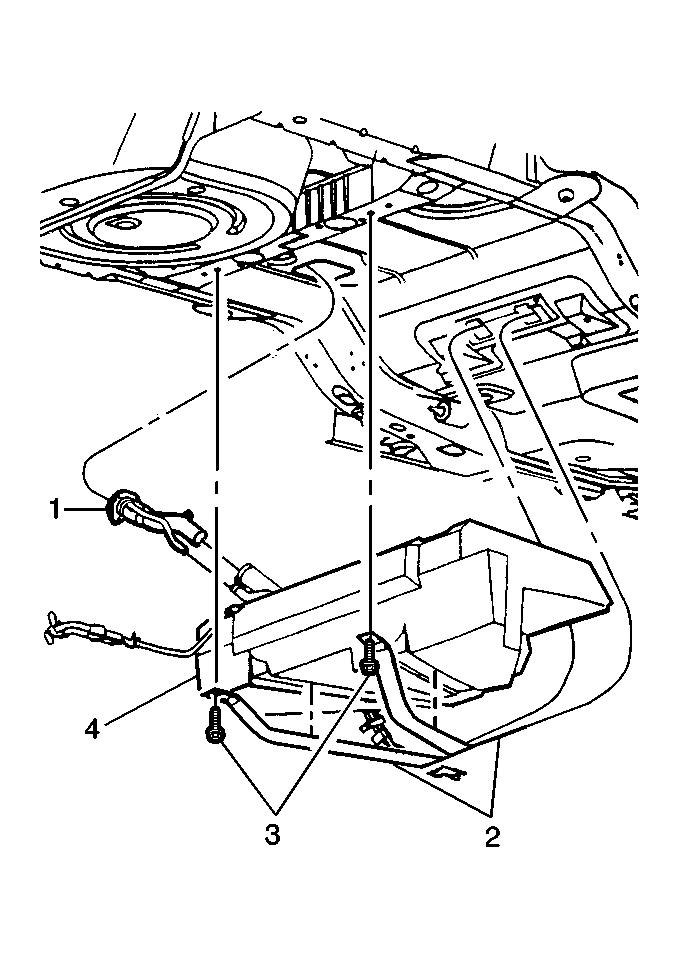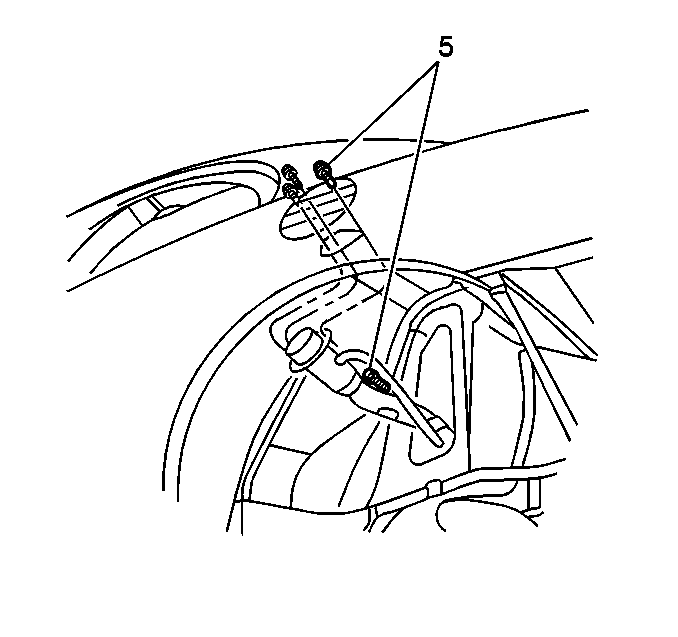Removal Procedure
Caution: Provide additional support when a vehicle is on a hoist:
• Before removing parts, support the opposite end. This helps prevent
the vehicle from slipping off. • Before removing major components, chain the vehicle frame to the
hoist pads at the same end as the removal. This helps avoid a tip-off.
Notice: Do not attempt to straighten any kinked nylon fuel lines. Replace any kinked nylon fuel feed or return pipes in order to prevent damage to the vehicle.
Important: Do Not attempt to repair sections of nylon fuel pipes. If the nylon fuel pipes are damaged, replace them.
- Relieve the fuel system fuel pressure. Refer to Fuel Pressure Relief .
- Drain the fuel tank (4). Refer to Fuel Tank Draining .
- Raise the vehicle.
- Remove the exhaust system. Refer to Exhaust System.
- Remove the wheel house filler pipe (1) opening cover in order to gain access to the fuel tank filler pipe.
- Remove the fuel tank filler pipe attaching screws. (5)
- Remove the fuel tank filler pipe hose clamps and the fuel tank filler pipe.
- Remove the fuel feed, fuel return, and vapor pipes near the fuel filter. Refer to Servicing Quick Connect Fittings .
- Remove the EVAP pipes and retainers at the evaporative emission canister.
- Remove the rear tie rod ends.
- Remove the rear suspension support assembly bolts and the lower suspension support assembly. Refer to Rear Suspension.
- Remove the fuel tank bolts (3) from the fuel tank (2) straps.
- Remove the fuel tank from the vehicle and place the fuel tank in a suitable work area.



Disassemble Procedure
- If the fuel tank is not being replaced, go to Installation Procedure.
- Disassemble the harness retaining straps (2).
- Disassemble the fuel feed, fuel return, and EVAP hoses.
- Disassemble the fuel sender assembly. Refer to Fuel Sender Assembly Replacement .

Assemble Procedure
- Assemble the fuel sender assembly. Refer to Fuel Sender Assembly Replacement .
- Assemble the fuel feed, fuel return, and EVAP hoses.
- Assemble the harness retaining straps (2).
- Assemble the fuel tank filler pipe and fuel tank filler pipe clamps.

Installation Procedure
- Position and support the fuel tank (4) with the aid of an assistant.
- Install the fuel tank straps (2).
- Install the rear suspension support assembly bolts and the lower suspension support assembly. Refer to Rear Suspension.
- Install the rear tie rod ends.
- Install the EVAP pipes and retainers at the evaporative emission canister.
- Install the fuel feed, fuel return, and vapor pipes near the fuel filter. Refer to Servicing Quick Connect Fittings .
- Install the fuel tank filler pipe hose clamps and the fuel tank filler pipe.
- Install the fuel tank filler pipe attaching screws (5).
- Install the wheel house filler pipe opening cover.
- Install the exhaust system. Refer to Exhaust System.
- Lower the vehicle.
- Add fuel and install the fuel tank filler pipe (1) cap.
- Install the negative battery cable.
- Inspect for leaks.

Tighten
Tighten the fuel tank strap bolts (3). Tighten the bolts to 48 N·m
(35 lb ft).
Tighten
Tighten the suspension support assembly bolts to 165 N·m
(122 lb ft).


| 14.1. | Turn the ignition switch to the On position for 2 seconds. |
| 14.2. | Turn the ignition switch to the Off for 10 seconds. |
| 14.3. | Turn the ignition switch to the On position. |
| 14.4. | Check for fuel leaks. |
